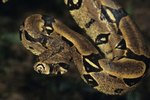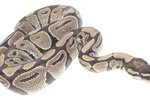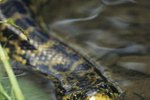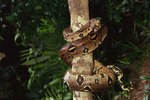
A boa constrictor living in captivity acts much as it would in the wild. A pet snake has a more predictable routine, but he will live, sleep, hunt and eat just like his tree-dwelling counterparts. With his distinct tan and brown skin and graceful glide, a boa makes an exotic and fairly trouble-free pet. A well-cared for boa constrictor can live up to 30 years.
Habitat Habits
In the wild, cold-blooded boas thrive in warm climates from Mexico to Argentina. Your pet boa needs a warm, spacious glass cage large enough to accommodate him if he grows to his potential length of about 12 feet. Boas are skilled escape artists with great wanderlust, so it's vital to provide a secure screen top that allows ventilation but prevents him from escaping. In cool climates, he will seek the comfort of a warming pad, heat strips, a heat lamp or ceramic heat emitter. Make sure his cage temperature never reaches more than 95 degrees.
Lounging Habits
Boa constrictors literally like to hang around. In the wild, they spend much of their time dangling from trees. Your pet boa will enjoy curling up on sturdy branches you place inside his cage. Boas appreciate a perch, and an overturned wooden box creates an additional level to climb. A hollow log provides a place for your scaly friend to find cool, dark privacy. If you provide an interesting habitat, he will slither around to explore it.
Sleep Habits
Your boa is nocturnal, so during the day he often coils up in a warm, sunny spot or hangs lazily from a branch. At night he becomes active and may crawl around his cage looking for prey.
Taste Test
When your boa flicks his tongue in and out, he is using it to test his surroundings. His taste is his most reliable sense, and his tongue collects information that helps guide him as he slithers along. His tongue can sense whether you are nearby or whether a tasty pinky mouse awaits its fate.
Eating Habits
Like other snakes, your pet boa is a meat eater. He has no fangs or venom to kill his prey, so he strikes at his victim, catches it with sharp teeth, then uses his muscular coils to squeeze the air out of the animal's lungs. Once the creature is dead, he will swallow it whole. Mice, rats and other small mammals or birds are popular on your boa's menu. Just place one in your boa's cage and he will do the rest. You can also feed your reptilian friend frozen prey, available in pet shops or through online suppliers. Although the prey is already dead, a boa will still constrict his meal before eating it. You will most likely see a bulge in his middle as he digests, a process that can take up to six days. He won't be ready to eat again for at least a week.
Shedding
As he ages, your boa outgrows his skin and leaves it behind. This process, called shedding, provides your snake with fresh, healthy scales. If you notice that your boa's shiny brown and tan scales seem cloudy or his eyes turn milky, it's likely he will soon shed his skin. The cloudy appearance is due to a lubricating material that appears between the old skin and the new. This substance can be seen in his eyes and inhibits his sight. He will usually lay low for several days during shedding and become more active when shedding ends and his eyesight returns. Juvenile snakes will shed more often than adults.
References
- University of Michigan Animal Diversity Web: Boa Constrictor
- Smithsonian National Zoological Park: Boa Constrictor
- National Geographic: Boa Constrictor
- Exploring Nature Educational Resource: Boa Constrictor
- Lee Richardson Zoo: Common Boa
- Western Australia Department of Agriculture and Food: RISK ASSESSMENTS FOR EXOTIC REPTILES AND AMPHIBIANS INTRODUCED TO AUSTRALIA – Boa Constrictor
Resources
Photo Credits
-
Jupiterimages/Photos.com/Getty Images
Writer Bio
Based in Los Angeles, Mary Helen Berg has been writing about pets, travel, families and parenting since 1989. Her work has appeared in publications such as "The Los Angeles Times" and "Newsweek." Berg holds a Master of Science from the Columbia University Graduate School of Journalism.




